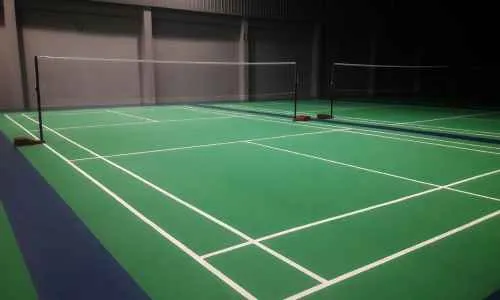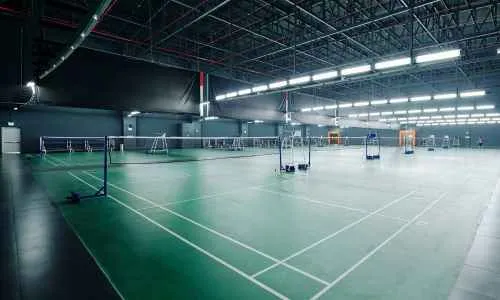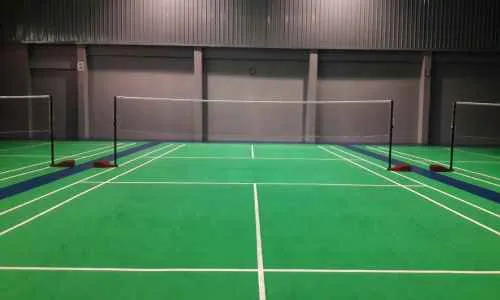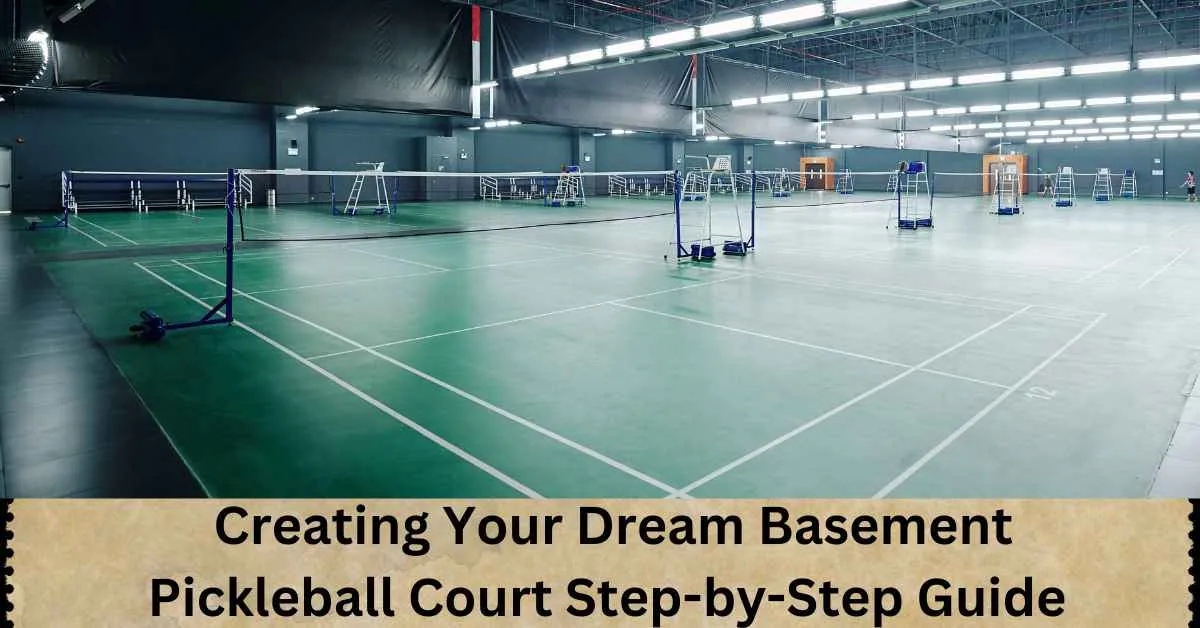Transform your basement with a fantastic Basement Pickleball Court. Get expert tips and ideas for your indoor paradise. Start playing today
Pickleball is a paddle sport based on badminton, tennis, and table tennis. It is played on a badminton-sized court with a tennis net that has been slightly changed. Players use solid paddles to strike a perforated plastic ball over the net. Pickleball can be played as either a singles or a doubles sport.
Having a basement pickleball court offers several benefits. It allows you to play pickleball year-round, regardless of the weather. It also provides a convenient place to practice your skills and host games with friends and family.
Table of Contents
Introduction
Are you ready to turn your basement into a fantastic pickleball court? You’re in the right place if you have some unused space in your basement and a passion for this fast-paced racquet sport. In this comprehensive guide, we will walk you through the steps to create the perfect basement pickleball court that will provide endless.
Designing Your Basement Pickleball Court
Now that you’ve got the basics down, let’s dive into the design aspect. Your basement pickleball court should not only be functional but also visually appealing. Planning a basement pickleball court involves several considerations, including the space required, flooring type, necessary equipment, and cost estimation. Now, we will examine each of these aspects in detail:
1. Space Requirements:
A pickleball court is 20 feet wide and 44 feet long. Divide the width into two 10-foot service areas. Separate the net’s length into two 22-foot portions, one on each side. Then, separate each 22-foot segment into a 7-foot non-volley zone and a 15-foot service area. The non-volley zone (called the “kitchen”) is closest to the net. While standing in the non-volley zone, players cannot volley the ball.
The service area is the area where players serve the ball. Players must serve from behind the baseline, and their serve must land in the diagonal service area on the other side of the court. The rest of the court is known as the “playing area .” Players engage in most of the action in this area during a pickleball game. The ideal ceiling height for a basement pickleball court should be 16 feet for proper clearance.
2. Flooring Type:
The choice of flooring is crucial for a basement pickleball court. The ideal flooring should provide cushioning, good traction, and durability. Common options include:
Rubber Flooring: Rubber tiles or rolls are famous for indoor pickleball courts. They offer excellent shock absorption and traction. Ensure the rubber flooring is of adequate thickness.
Interlocking Tiles: Interlocking plastic or PVC tiles are easy to install and provide a comfortable playing surface.
Hardwood: Some players prefer hardwood floors, but they should have the right finish to reduce slipperiness. Concrete is the most durable option, but it can be slippery
3. Necessary Equipment:
Besides the playing surface, you’ll need essential equipment for your basement pickleball court:
Pickleball Net and Posts: Install a regulation-height pickleball net and sturdy posts at the centerline of the court.
Pickleball Paddles: Acquire enough paddles for the players. Choose paddles that suit your playing style and level.
Pickleballs: Purchase a set of pickleballs, which are specifically designed for pickleball and come in various types and colors.
Proper lighting: Proper lighting is essential for a great playing experience. Install bright LED lights to ensure excellent visibility. Consider adding stylish fixtures to enhance the aesthetics.
Wall Color: Choose a light, non-reflective color for the walls to improve visibility and prevent distractions during play.
Seating: Depending on your preferences, add benches, chairs, or seating areas for players and spectators.
Storage: Create storage solutions for pickleball equipment, such as paddles and balls.
Safety Gear: Consider safety gear like first-aid kits and padding for walls and sharp edges.
4. Cost Estimation:
The cost of building a basement pickleball court can vary widely depending on factors like location, materials, and labor. Here is an estimated figure:
Flooring: Flooring materials can cost anywhere from $2 to $6 per square foot, depending on the type and quality of flooring you select.
Net and Posts: A regulation pickleball net and posts can cost between $100 to $300 or more.
Lighting: Lighting fixtures can vary in price, but budget for at least a few hundred dollars for adequate lighting.
Pickleball Equipment: Paddles and balls can range from $50 to $150 per set.
Seating and Storage: Costs for benches, chairs, and storage solutions will depend on your preferences and budget.
Installation and Renovation: Labor costs for installation, including flooring and any renovations or modifications to the basement, can vary significantly.
Obtaining quotes from contractors, flooring suppliers, and equipment retailers is essential to get a more accurate estimate based on your specific needs and location. Additionally, consider any permits or zoning requirements in your area, as they may add to the overall cost.

Building your basement pickleball court
Building a basement pickleball court involves several key steps, from preparing the space to adding essential features. Here’s a detailed guide on how to go about each of these stages:
1. Preparing the Space:
Clear the basement of any clutter, obstacles, or debris to create a clean, open playing area.
Ensure that the basement has air circulation to maintain a comfortable playing environment. Consider adding fans or vents if needed. Address any moisture or humidity issues, as dampness can damage flooring and equipment. Install a dehumidifier if necessary.
2. Installing the Flooring:
Choose a suitable flooring material that provides cushioning and good traction. Rubber flooring or interlocking tiles are popular choices for pickleball courts. Start by cleaning and leveling the existing basement floor. Fill in any cracks or imperfections. Lay down the chosen flooring material, ensuring it covers the entire playing area. Properly secure or glue the flooring as per the manufacturer’s instructions. Ensure the flooring is smooth and free from any bumps or wrinkles that could cause tripping hazards.
3. Marking the Court Lines:
Measure and mark the court dimensions on the flooring. For a standard single and doubles court, this is 20 feet wide and 44 feet long. Use masking tape or court paint to create clear boundary lines, including the baseline, sidelines, and non-volley zone (kitchen) if space allows. Ensure the lines are straight and properly spaced to meet official pickleball dimensions.
4. Installing the Net:
Set up a regulation pickleball net and sturdy posts at the centerline of the court. The net should be 36 inches high at the sidelines and 34 inches at the center. Secure the net tension according to official rules, ensuring it is taut and at the correct height.
5. Adding Other Features:
Lights: Install bright, evenly distributed lighting fixtures to eliminate shadows and ensure optimal visibility. People often use LED or fluorescent lighting for indoor pickleball courts.
Seating: Consider adding seating for players and spectators. You can make this simple as positioning benches or chairs along the sidelines.
Storage: Create storage space for pickleball equipment like paddles, balls, and other gear. Cabinets, shelves, or storage bins can help keep the area organized.
Soundproofing: If noise is a concern, invest in soundproofing materials to reduce sound transmission to the rest of your home. You may include acoustic panels, rugs, or wall coverings for soundproofing.
Building a basement pickleball court can be a rewarding project that provides a fun and convenient space for play, so take the time to plan and execute each step carefully.

Tips for maintaining your basement pickleball court
Maintaining your basement pickleball court is essential to keep it safe and playing well. Here are some tips for effectively keeping your court:
1. Cleaning and Debris Removal:
Wax the floor every few months to protect it from scratches and scuffs. Regularly clean the playing surface to remove dust, dirt, and debris. Use a broom, vacuum cleaner, or a dust mop designed for sports floors. Avoid using abrasive or harsh cleaning agents, which can damage the flooring material. Promptly clean up any spills or stains to prevent them from becoming permanent.
2. Inspecting the Net and Equipment:
Conduct routine inspections of the pickleball net, net posts, and other equipment to identify any signs of wear or damage. Check the net tension to ensure it meets regulation height and remains taut during play. Examine the net for tears, fraying, or loose fasteners, and address any issues promptly. Inspect the posts for stability and signs of rust or corrosion, especially if your basement has moisture issues.
3. Making Repairs:
Address any issues or damage as soon as you discover them to prevent further deterioration. Repair or replace damaged flooring tiles or sections promptly. You may need to re-glue loose tiles or replace ones beyond repair. If your court has wall padding or barriers, ensure they are securely in place and replace any damaged padding. Fix or replace any lighting fixtures that are flickering or malfunctioning. Lubricate moving parts of the net tension system to prevent stiffness or rust.
4. Climate Control:
Maintain a stable climate within your basement pickleball court to prevent moisture-related issues. Use a dehumidifier if necessary to control humidity levels. Ensure the temperature remains comfortable for play and does not subject the court to extreme temperature fluctuations.
5. Regular Maintenance Schedule:
Create a maintenance schedule that includes regular inspections, cleaning, and maintenance tasks. Keep records of maintenance activities, including repairs and replacements, to track your court’s condition over time.
6. Safety Considerations:
Always prioritize safety when making repairs or adjustments. Ensure that you do repairs correctly and that all equipment meets safety standards. If you need help performing maintenance tasks or repairs, consider hiring professionals specializing in pickleball court maintenance or consult the manufacturer for guidance.
7. Replace Consumables:
Pickleballs and paddles can wear out over time, so periodically assess their condition and replace them as needed. Check the condition of any seating, benches, or storage solutions and replace or repair them if necessary.
By following these maintenance tips and staying proactive in caring for your basement pickleball court, you can ensure that it remains a safe and enjoyable space for playing the sport. Regular inspections and prompt repairs will help extend the life of your court and keep it in excellent condition for years to come.

How to get the most out of your basement pickleball court
To get the most out of your basement pickleball court, consider the following ways to enjoy and maximize its use:
1. Hosting Games with Friends and Family:
Invite friends and family to play pickleball in your basement. Organize friendly matches, tournaments, or regular game nights. Create a welcoming and comfortable space with seating, refreshments, and a scoreboard to enhance the experience. Hosting games at home allows you to enjoy the convenience of playing whenever you like, regardless of the weather outside.
2. Taking Pickleball Lessons:
Invest in your skills by taking pickleball lessons from experienced coaches or instructors. Many instructors offer private or group lessons, both in person and online. Lessons can help you improve your technique, strategy, and overall gameplay. They are especially beneficial for beginners looking to learn the fundamentals. Regular practice and coaching can accelerate your progress and make playing on your basement court more enjoyable.
3. Organizing Pickleball Events:
Consider hosting pickleball events and inviting fellow players from your community or social circle. Events could include round-robin tournaments, charity fundraisers, or themed pickleball parties. Organizing events provides fun and socializing opportunities and strengthens your area’s pickleball community.
5. Incorporating Technology:
Use video recording equipment to record your games and analyze your performance. Identifying areas for improvement and refining your skills can be achieved through this.
6. Customizing Your Space:
Personalize your basement pickleball court by adding posters, memorabilia, or other decorations related to the sport. Consider upgrading the lighting, seating, or flooring to improve comfort and aesthetics.
You can also use your basement pickleball court to practice your skills. Here are a few drills and games you can try:
Wall drills: Hit the ball against the wall and try to catch it on your paddle.
Serve drills: Practice serving the ball into different areas of the court.
Volley drills: Practice volleying the ball back and forth with a partner.
Pickleball games: Play pickleball singles or doubles with friends and family.
Can I play pickleball in my basement?
Yes, you can play pickleball in your basement with enough space and appropriate flooring. Consider the ceiling height and safety precautions for a fun and safe game.
Conclusion
In conclusion, this complete guide has given you all the information you need to create and keep up a pickleball court in your basement. Having an indoor pickleball court has many benefits and can be enjoyed by casual players and enthusiastic fans. So, consider building your pickleball court in the comfort of your basement.
It’s time to jump in, have fun, stay fit, and connect with the pickleball community. A basement pickleball court is a great way to enjoy the sport year-round. You should construct your court if you have the necessary resources and space. You will not be disappointed!

